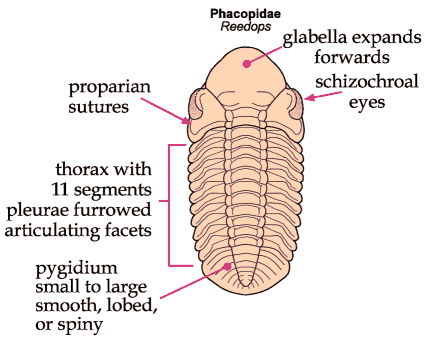TO THE ORDER PHACOPIDA
last revised 05 August 2007 by S. M. Gon III
If you have any feedback on this page
Please email me to let me know
Suborder Phacopina

Here are some representative members of Suborder Phacopina:

Here are some representative members of Suborder Phacopina:
| Acastoides | Pennaia | Asteropyge | Dalmanites | Huntoniatonia | Phacops |
 |
 |
 |
 |
 |
 |
| Suborder Phacopina
Cephalon: proparian sutures (sometimes fused), schizochroal eyes; glabella expands forwards; librigena typically yoked as single piece; hypostome conterminant to impendent, some with no rostral plate; some with genal spines. Thorax: 10 to (typically) 11 segments, pleurae furrowed, articulating facets distinct, rounded, angular, or spinose tips. Pygidium: typically smaller than cephalon (but subisopygous in Dalmanitoidea and Acastoidea), smooth or spinose. Superfamilies: Phacopoidea, Dalmanitoidea, Acastoidea Characterizations of the three Phacopine superfamilies: Superfamily Phacopoidea Cephalon: generally with strongly divergent axial furrows (glabella greatly expanding anteriorly), anterior glabellar lobes fused into single anterior tri-composite lobe, frontal area generally lacking (obliterated by large glabella), eyes (when present) typically anterior; genal angle typically rounded, without genal spines (exceptions among Pterygometopidae), vincular furrow generally present. Thorax: variable, but often with rounded tips. Pygidium: typically micropygous (Phacopidae) to subisopygous (some Pterygometopidae), not spinose. Families: Phacopidae, Pterygometopidae Genera: Ductina, Kainops, Phacops, Pterygometopus, Reedops, Superfamily Dalmanitoidea
Superfamily Acastoidea
|
PHACOPIDA includes three Suborders
| Phacopina | Calymenina | Cheirurina |
